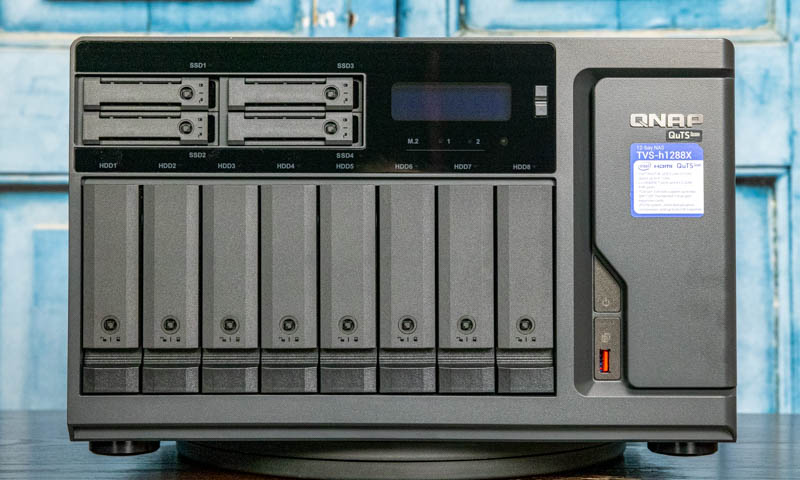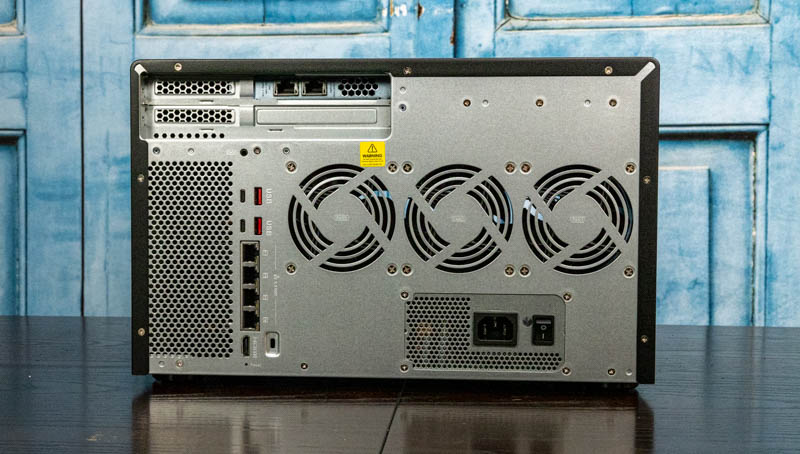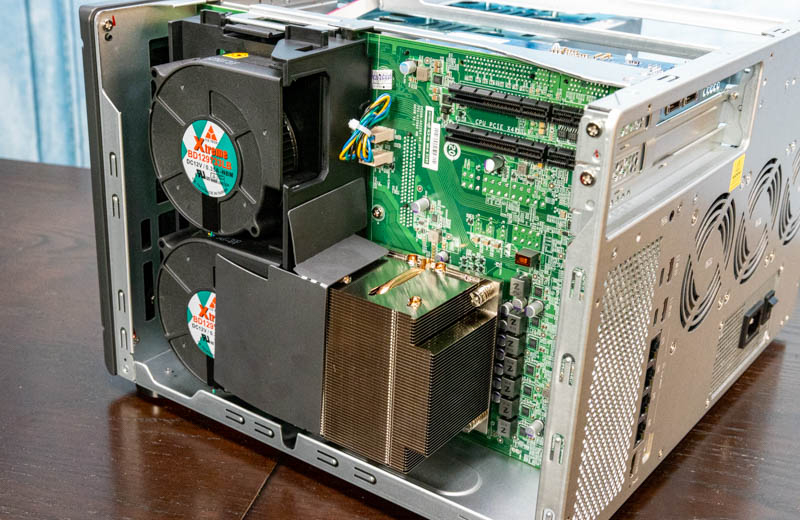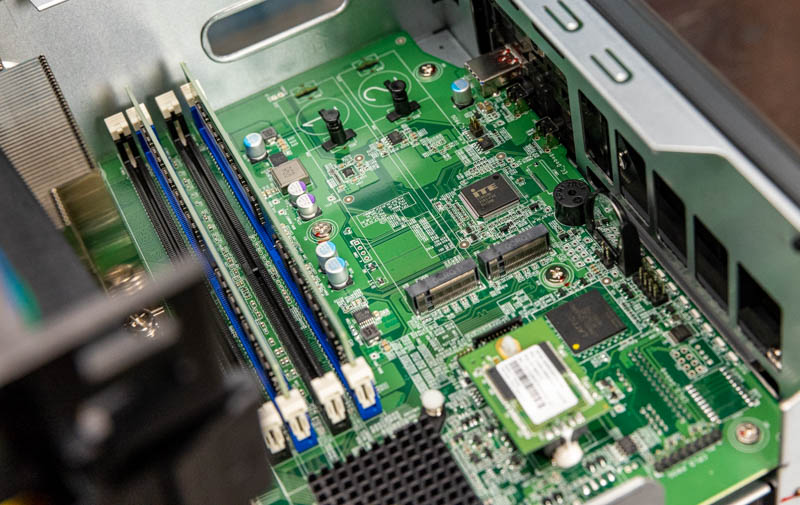QNAP TVS-h1288X Market Impact
After testing the TVS-h1288X we get back to the key framing concept we started this review with, that QNAP built that excellent home/ SMB server. There are some caveats, but they make sense.
First, in terms of pricing at the time of this review, this is a $2500 unit. That is far from inexpensive. Our sense is one could build something roughly similar for around half of the final cost of this machine.

Looking at the competition, the TrueNAS Mini XL+ is a ZFS NAS that has 8-bays but has three fewer 2.5″ bays and one less internal bay. It also has four fewer 2.5GbE ports, cannot be expanded for Thunderbolt, and still has a fairly decent gap between TrueNAS and QuTS hero in terms of software. It does have 32GB of memory though.
The Synology DiskStation DS3617xs is perhaps the most comparable unit at this price point, but that is 12x 3.5″ + 0x 2.5″ versus the TVS-h1288X which is 8x 3.5″ and 4x 2.5″. QNAP is using a 5-year newer processor than Synology that is faster. QNAP also has 2.5GbE instead of 1GbE onboard which is much more modern. Synology tends to use lower-end older hardware while QNAP provides newer higher-end hardware. Some may prefer Synology’s suite, but this is perhaps the best comparison. If you prefer QNAP’s management and features and are nervous about Synology’s numerous moves to start vendor locking its ecosystem, the QNAP is going to be the better option.

The interesting facet around this system is that it is probably best thought of as not just a NAS. Realistically, the value QNAP is providing versus a self-built and self-managed ZFS on Linux NAS is that QNAP makes it easier to deploy. One does not have to pick the parts. Fans are matched and curves are already set for a user. There is no need for an OS install tuning items. Beyond the hardware, the software side is designed to be a NAS, but really QNAP is building an edge server platform. Instead of looking at how to install many common applications on a server, QNAP has an app store. Whether one wants a directory server, collaboration server, web server, Plex server, or another feature, this is built-in.

The reason one buys a TVS-h1288X is not that it is impossible to build and maintain one’s own NAS and server. The reason one buys the unit is that it makes the process easy. Going beyond buying one for a small business whether that is an office or a home office, the ability for businesses with multiple small locations to simply order a unit and have it shipped and quickly set up to a location is a very valuable benefit as well. QNAP’s model is effectively that a business can buy this box, and run what they need on it. For the SMB sector, a business that can build on QNAP virtualization and containers instead of VMware and big server vendor solutions can mean huge cost savings.
Final Words
Overall, there is a lot to like in this system. Perhaps the one item that was a bit disappointing is that it feels like this should have been a 32GB unit at this price point. One can upgrade, but it simply feels like given some competition and the price level, that 32GB would have been a great fit. For many of STH’s readers, they may look at this unit and see the virtualization/ container features and know of ZFS’s need for memory, and immediately want to run more on this system. An upgrade to 32GB or 64GB makes a lot of sense.

Years ago, pre-cloud, there was a more vibrant scene for servers in small businesses and at home. Now, with the focus pushing back to the edge, we are seeing a renewed interest in this class of machines. What is interesting is that the functionality of these types of devices has increased severalfold over the years as processors and networking technology have gotten better. While QNAP primarily markets this as a NAS, perhaps the best way to look at it is as an edge server that also has storage features.




I have the 9 bay TS-h973AX AMD Ryzen NAS, running QuTS Hero. My first QNAP NAS after a couple of Synology. I specifically bought it for the mix of ZFS NAS dedup and compression with the nice addition of the app ecosystem. Mine stores multiple, very similar linux VDI VMs on an iSCSI connected datastore and is achieving impressive data storage reductions, and I am really happy with the storage performance across the inbuilt 10 and 2.5GBe network ports. I am using 5 Ironwolf HDDs and 2 intel enterprise NVME drive for caching and ZIL log.
I used to work in the enterprise server/storage areas, and this really seems to perform as well as some of the old HP/EMC storage systems I worked with. As well as being my PLEX media server…
I really think this is a significant step-change for SMB/homelab setups, after a good few years of ‘meh’ NAS device updates. I had my last Synology for 5 years, never saw a reason to update it until I saw the QNAP/ZFS solution…
Not so much about this product but the state of the market:
* While I’m glad to see 2.5 Gbps appearing, NBase-T would be preferable. Do you know why it’s shipping on so few products, I assume cost?
* Is there any indication of a next-rev Xeon-D?
QNAP keeps pushing the envelope…nice review!
100W “Idle” seems a bit excessive, does this have a BMC? Is it possible to simply install Linux on it since it’s all standard components?
i want this case with another hardware and OS for home server
Great review, but it lacks recent news regarding Qnap devices around the world facing ransomeware:
https://www.bleepingcomputer.com/news/security/massive-qlocker-ransomware-attack-uses-7zip-to-encrypt-qnap-devices/
Appears to be a pattern of failed security, including hard-coded passwords in backdoors:
https://www.reddit.com/r/qnap/comments/mwo72h/with_all_the_ransomware_attacks_i_highly/
I was close to buying this new unit with 16-drives. Perhaps after some significant improvement!
And six months after being notified of their breached webserver, no remediation:
https://securingsam.com/new-vulnerabilities-allow-complete-takeover/
And cryptocurrency mining, also unfixed:
https://heimdalsecurity.com/blog/unpatched-qnap-nas-devices-targeted-by-unityminer/
Thanks for the great Large QNAP NAS review. STH is comprehensive and just plain forthright and honest every time.
For my SOHO my 1st NAS I is a Synology DS-218+. A little great 2-bay. I upgraded May 2020 to a QNAP TS-253D (another 2 bay). That little TS-X53D family NAS has a few pre-view features its much large big brother. It has multiple 2.5GB ports (easy to port aggregate), many USB ports (compatible with all of the 2.5 & 5Gb Adapters reviewed by STH), and a full PCIe slot (to use any of the many QNAP PCIe 10Gb NIC & NIC/Memory cards).
The QNAP QTS OS does take a long while to boot and shutdown. To me along with the size of the hard drives the up & down times also appears to be related to the number of Apps installed, Snapshots & Virtual machines configured, etc. The variable speed fan is pretty quiet but the constant HD noise along with the Synology NAS HD’s clearly is annoying in a quiet office space.
Synology & QNAP have regular OS software updates and frequent App updates.
no das option for thunderbolt
What was the nuc video, couldn’t find.
Get ready for your product to be infected by ransomware, loose all your files and QNAP not taking any action nor responsibility at all. Stay as far away from QNAP as you possibly can!!
To me, this is overpriced, too power hungry, and deceptive.
It’s not really a DAS, as claimed by the advertising folk at QNAP. It uses Firewire-over-IP for the Thunderbolt connection, so every device on the Thunderbolt bus that is attached to the NAS will be taken over by the NAS (monitors, external PCIe enclosures, and so on). If your PC has only one thunderbolt port, this is a real issue.
Next, consider the price point. For that kind of money, you can buy a really nice SM board like the X10SDV-7TP4F with lots of SATA expansion options, real server features like a BMC, and dual SFP+, two standard PCIe 3.0×8 slots, NVME at 3.0×4, mSATA, a on-board LSI HBA, and so on. Even with a case, 64GB of RAM, two SATADOMs, a Ti power supply, etc. the whole package comes out to ~$2k, and consumes less than 120W with a full eight 3.5″ HDD and six 2.5″ SDD loadout.
Better yet, these are standard components that are easy to replace, not custom stuff that you can only get from QNAP. Add TrueNAS to the setup (Free) and you have a better ZFS storage implementation than QNAP at a lower cost. The only downside is that the TrueNAS UI will make you work a lot harder than the QNAP UX and there are far fewer plug-ins.
As a QNAP NAS owner for about 2 years and witnessing the ransomware attacks I can say that QNAP has not ignored it. They mention it on their forums and their Reddit, they give hotfix software updates, and they tell you what to disable in the NAS until a hotfix is released. They appear very transparent.
To avoid getting ransomware, basically practice general security measures that you would do on any server.
1. Have a firewall router in your home and don’t set your NAS as a DMZ.
2. Only use the built-in admin account to configure a secondary admin account under a unique username and disable the default admin account.
3. Keep SSH disabled when not using it.
4. Disable apps that aren’t being used.
5. BACKUP!! WHILE RAID6 is great, you really should also be backing up on external hardware or the cloud like Backblaze.
Every vendor and every device can be hacked. Keep your attack surface small and be smart.